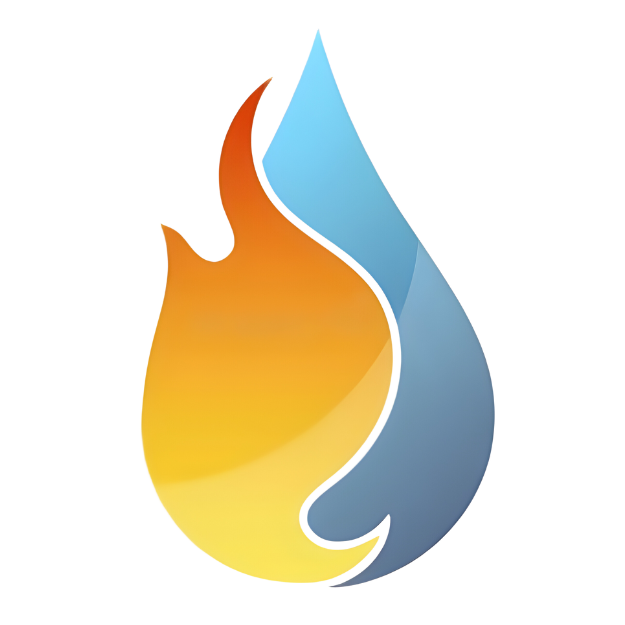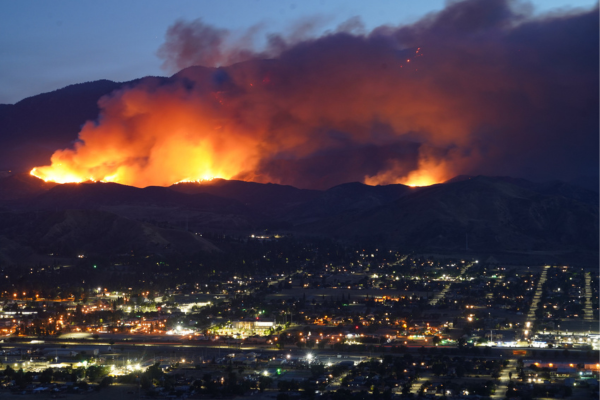The 2025 California wildfires have already left an indelible mark on the state, with flames ravaging communities and straining emergency resources. These fires, driven by intense Santa Ana winds and fueled by dry conditions, have spread with alarming speed, threatening tens of thousands of homes and forcing mass evacuations. Residents have faced heartbreaking losses, while responders have grappled with unpredictable fire behavior under some of the harshest conditions in recent memory.
Beyond the immediate devastation, the fires have profound implications for the environment and infrastructure. Entire neighborhoods have been reduced to ash, critical roads have been blocked, and iconic landscapes have been scarred. Air quality has plummeted, affecting millions, and power outages have disrupted daily life for hundreds of thousands.
Understanding what caused these wildfires, the contributing factors, and the responses in place is critical for protecting communities in the future. From the role of climate change to the immediate dangers posed by fierce winds, exploring these elements helps shed light on this destructive natural phenomenon—and how we can better prepare for what’s to come.
What Caused the 2025 California Wildfires?
The Role of Weather Conditions
The 2025 wildfires were a perfect storm of hazardous weather conditions. The notorious Santa Ana winds, known for their ability to fan flames rapidly across the landscape, were particularly fierce this season. Gusts reached hurricane-force speeds of over 112 km/h in many areas, creating a tinderbox environment. Combined with months of little to no rainfall, the dry vegetation became ideal fuel for fires to ignite and spread uncontrollably.
The Impact of Climate Change
Climate change has played a significant role in increasing both the frequency and severity of wildfires in California. Rising global temperatures have extended drought conditions, leaving forests and brushlands drier for longer periods. This creates a scenario where even a small spark can result in catastrophic wildfires. Additionally, warming trends have altered wind patterns, making events like the Santa Ana winds more intense and unpredictable.
Human-Related and Natural Ignition Sources
While natural factors such as lightning strikes can ignite wildfires, human activity remains a leading cause. In recent years, downed power lines, careless campfires, and even sparks from vehicles have been responsible for starting fires. In 2025, investigations into the origins of the Palisades Fire and others are still ongoing, but human involvement is suspected in at least one case. Regardless of the cause, the combination of ignition sources and ideal fire conditions has resulted in one of the most destructive wildfire seasons in recent history.
Key Wildfires in Los Angeles
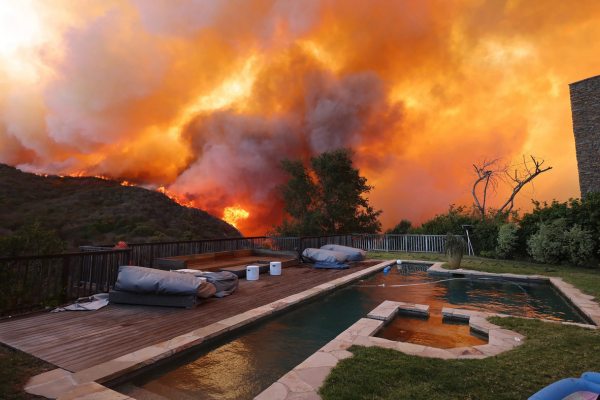
The Palisades Fire
The Palisades Fire erupted in the affluent Pacific Palisades neighborhood on the morning of January 7, 2025, and quickly grew into a massive blaze. Fueled by intense Santa Ana winds, the fire spread across dry vegetation, creating a plume of smoke visible for miles.
Timeline of Events
- Morning, January 7: The fire was first reported around 10:30 AM. Within hours, it had consumed thousands of acres.
- Afternoon: Evacuations began for over 30,000 residents as flames encroached on neighborhoods.
- Evening: The fire spread to Malibu, crossing major roads like the Pacific Coast Highway and engulfing homes and businesses.
Impact on Pacific Palisades, Malibu, and Surrounding Neighborhoods
The Palisades Fire tore through hillside homes, forcing residents to abandon vehicles and flee on foot. Multi-million-dollar properties, including iconic sites like Temescal Canyon, were caught in its path. Even schools like Palisades Charter High, known for its Hollywood appearances, were damaged by the flames.
Threats to Homes, Schools, and Cultural Landmarks
Entire neighborhoods were threatened as flames crossed roadways and ignited dense areas of vegetation. Temescal Canyon, a popular hiking spot, and surrounding residential areas experienced significant destruction, highlighting the fire’s reach and unpredictability.
The Eaton Fire
Breaking out in Altadena, a community nestled in the hills northeast of Los Angeles, the Eaton Fire quickly became another major concern. It began on the evening of January 7 and spread rapidly, propelled by the same wind conditions driving the Palisades Fire.
Location and Spread
The fire originated in the foothills above Altadena, an area known for its scenic beauty and tight-knit neighborhoods. Within hours, it had scorched over 1,000 acres, threatening nearby homes and natural preserves.
Evacuations and Damages
Evacuation orders were issued for Altadena residents as firefighters battled to contain the flames. Though no official damage estimates are available yet, reports suggest significant losses in property and infrastructure.
The Hurst Fire
Late on January 7, the Hurst Fire erupted in Sylmar, a northern Los Angeles neighborhood in the San Fernando Valley. This blaze escalated rapidly, consuming hundreds of acres overnight.
Rapid Escalation
High winds carried the flames across Sylmar’s dry terrain, creating an immediate threat to nearby homes and businesses. The fire’s rapid pace caught residents off guard, prompting swift evacuation efforts.
Evacuation Measures and Containment Challenges
Evacuations in Sylmar were complicated by limited road access and the fire’s erratic behavior. Firefighters faced immense challenges in containing the blaze due to the relentless winds and lack of aerial support.
The Role of Santa Ana Winds
What Are Santa Ana Winds?
Santa Ana winds are strong, dry winds that originate inland and blow toward Southern California’s coastal regions. Known for their hot and desiccating nature, these winds are notorious for creating prime conditions for wildfires.
How High-Speed Winds Exacerbate Wildfires
The 2025 fires illustrate how Santa Ana winds amplify wildfire destruction:
- Increased Spread: Wind speeds exceeding 112 km/h pushed flames across roads, canyons, and urban areas, making containment nearly impossible.
- Spot Fires: Embers carried by the winds sparked new fires, complicating firefighting efforts.
- Reduced Aerial Support: Strong gusts grounded firefighting aircraft, leaving ground crews to battle the flames unaided.
Comparing 2025 to Previous Wind-Driven Wildfires
The 2025 wildfires bear resemblance to past disasters fueled by Santa Ana winds, such as the 2017 Thomas Fire and the 2018 Woolsey Fire. However, the intensity of this year’s winds—combined with extended drought conditions—has made this season one of the most destructive in recent memory.
4. Impacts of the Wildfires
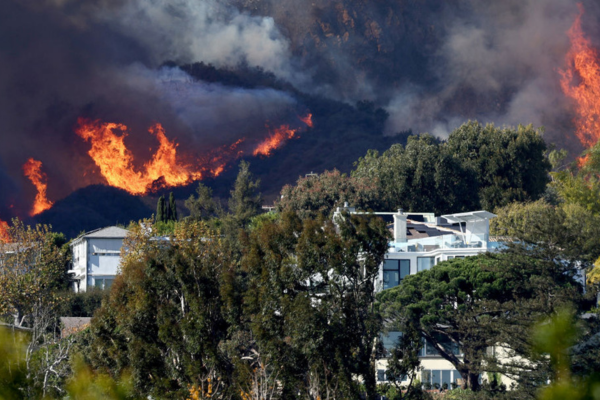
Human Impact
The 2025 California wildfires have left a profound mark on the lives of those affected.
Evacuations
Residents were forced to flee their homes as flames spread rapidly through neighborhoods. In Pacific Palisades, families abandoned their cars on clogged roadways and fled on foot, some carrying pets, children, and hastily packed bags. The chaos was palpable as panicked residents sought safety amidst towering flames.
Displacement of Vulnerable Groups
One of the most harrowing stories came from a senior living center near Altadena, where staff pushed residents in wheelchairs and hospital beds down the street to escape the flames. Among them was a 102-year-old woman, waiting in the open air for transport to safety. Vulnerable groups faced immense challenges as emergency services worked tirelessly to evacuate those in need.
Burn Injuries and Fatalities
The fires have resulted in multiple burn injuries, with several individuals hospitalized, including firefighters. Tragically, fatalities have been reported, underscoring the deadly nature of these wildfires.
Property and Infrastructure Damage
Destruction of Homes and Businesses
Entire neighborhoods have been reduced to ash, with multi-million-dollar homes in Pacific Palisades and Malibu among the losses. Businesses along the Pacific Coast Highway, a critical artery for the region, were also destroyed, disrupting livelihoods.
Damage to Iconic Locations
The fires consumed parts of Temescal Canyon and jumped Sunset Boulevard, causing significant damage to Palisades Charter High School, a landmark featured in numerous Hollywood productions.
Widespread Power Outages
Over 200,000 residents lost power as strong winds downed electrical lines and transformers exploded. This has further complicated evacuation efforts and daily life for those in unaffected areas.
Environmental Impact
Loss of Vegetation
Natural preserves and urban green spaces have been scorched, stripping the landscape of vegetation that supports local ecosystems. Temescal Canyon and other hiking areas have been devastated, with long-term recovery expected to take years.
Air Quality Issues
Thick smoke has blanketed the region, causing severe air quality problems. Residents are experiencing respiratory issues, with health officials urging people to stay indoors and use air purifiers.
Health Hazards
Falling ash and airborne toxins from burning materials pose ongoing health risks. Vulnerable populations, including children and the elderly, are particularly at risk.
5. Emergency Response and Challenges
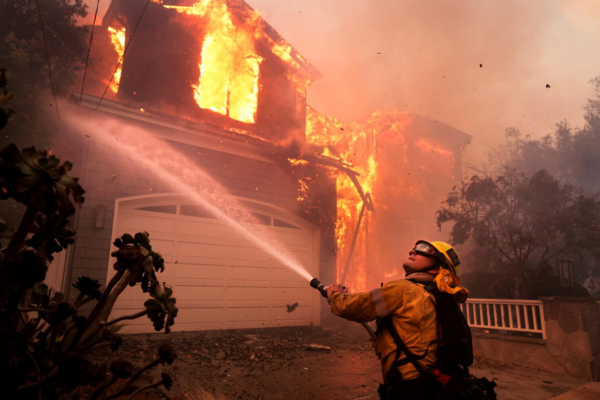
Efforts by Firefighters and First Responders
Firefighters and first responders have worked tirelessly to combat the flames and evacuate residents. Over 1,400 firefighting personnel were deployed statewide, supported by local law enforcement and emergency medical teams.
Strain on Resources
With three major wildfires burning simultaneously, resources were stretched thin. Firefighting crews faced exhausting shifts as they battled flames under some of the most extreme conditions seen in years.
As the fire continued to grow, the Federal Emergency Management Agency announced that they had approved a Fire Management Assistance Grant request made by state leaders.
“At the time of the request, the fire was threatening approximately 8,200 homes in and around Altadena and Pasadena, California, population 40,000,” said the statement from FEMA.
The federal funding will allow local departments up to 75 percent of eligible firefighting costs used during the firefight, the statement said (CBS News, 2025).
Role of Off-Duty Firefighters and Federal Aid
In a rare move, the Los Angeles Fire Department called in off-duty firefighters to join the effort. Federal support, including grants and additional resources, was crucial in bolstering local efforts.
Weather Challenges
Hurricane-force winds rendered firefighting aircraft unusable, forcing crews to rely solely on ground operations. This limitation significantly hampered containment efforts, allowing the fires to spread more rapidly.
6. Government and Federal Action
Declaration of a State of Emergency
California Governor Gavin Newsom declared a state of emergency, ensuring the allocation of resources to combat the fires and support affected communities. He visited impacted areas, emphasizing the state’s commitment to recovery.
Gov. Gavin Newsom posted on X early Wednesday that California had deployed more than 1,400 firefighting personnel to combat the blazes. “Emergency officials, firefighters, and first responders are all hands on deck through the night to do everything possible to protect lives,” Newsom said.
Deployment of Resources
State and local agencies deployed personnel, equipment, and emergency services to affected areas. Evacuation centers were established to provide temporary shelter for displaced residents.
Federal Support
President Joe Biden approved federal aid, including grants to offset firefighting costs. FEMA’s involvement provided additional relief, helping local agencies focus on immediate needs.
7. Safety Tips for Wildfire Preparedness
Prepare Your Home
- Create Defensible Space: Clear vegetation and debris within 30 feet of your home to reduce fire risk.
- Use Fire-Resistant Materials: Invest in roofing, siding, and windows designed to withstand high heat.
- Seal Gaps: Close gaps around doors and windows to prevent embers from entering your home.
Emergency Kits and Evacuation Plans
- Emergency Kits: Stock essentials such as water, non-perishable food, medications, flashlights, and first aid supplies.
- Evacuation Plans: Identify multiple evacuation routes and practice them regularly with your family.
What to Do If You’re Caught in a Wildfire
- Stay Low: Keep as close to the ground as possible to avoid smoke inhalation.
- Cover Your Face: Use a wet cloth to shield your nose and mouth.
- Find Shelter: If unable to evacuate, seek refuge in a cleared area or non-combustible structure.
8. Restoration After Wildfire Damage
Restoring your home after wildfire damage begins with a thorough assessment. Inspect both the interior and exterior for structural issues, soot, and smoke damage. Water damage caused by firefighting efforts is also common and requires immediate attention to prevent mold and further deterioration. Prioritize identifying hazards such as compromised foundations or electrical systems before proceeding with repairs.
Once the damage is assessed, focus on immediate restoration steps like removing soot, drying damp areas, and eliminating smoke odors. Professional services are often necessary for deep cleaning and structural repairs. For long-term recovery, work with your insurance provider to file claims, rebuild with fire-resistant materials, and create defensible space around your home to mitigate future wildfire risks.
The 2025 California wildfires highlight the devastating impacts of natural disasters, underscoring the need for preparedness and swift restoration. Protecting your home and rebuilding with resilience is essential for long-term safety. For professional support in fire, smoke, and water damage recovery, trust Tri-State Ready Restoration to help you rebuild stronger and safer—contact us today to get started.
FAQs About the California Wildfires
Where did the California wildfires start?
The 2025 California wildfires began in several locations across Southern California, with major blazes originating in Pacific Palisades, Altadena, and Sylmar. These areas, already prone to wildfires, became the epicenter of destruction due to severe wind conditions.
Where are the California wildfires located?
The wildfires are primarily concentrated in Los Angeles County, affecting neighborhoods such as Pacific Palisades, Malibu, Altadena, and Sylmar. The fires have also spread into surrounding hills, foothills, and natural preserves.
Why are the California wildfires so bad?
The 2025 wildfires are exceptionally destructive due to several factors, including prolonged drought, extreme Santa Ana winds reaching over 112 km/h, and highly flammable vegetation. These conditions combined to create the perfect storm for rapid fire spread and devastating impacts.
Did the Palisades Village burn?
No, Palisades Village, a popular shopping and dining area, was not directly affected by the fire. However, surrounding neighborhoods in Pacific Palisades suffered significant damage, with many homes destroyed or severely impacted.
What are 90% of fires caused by?
Around 90% of wildfires are caused by human activity. These include downed power lines, discarded cigarettes, unattended campfires, arson, and sparks from machinery. The remaining 10% are caused by natural events like lightning.
When did the California wildfires in 2025 start?
The 2025 California wildfires began on the morning of January 7, 2025. The Palisades Fire was first reported around 10:30 AM, quickly escalating due to high winds and dry conditions.
Where exactly is the Palisades Fire?
The Palisades Fire is located in the Pacific Palisades neighborhood of Los Angeles, California. It originated near Temescal Canyon and spread rapidly through the hillside areas, eventually reaching parts of Malibu and other nearby communities.
Article Citations:
- FEMA Fire Management Assistance Grant Announcement: CBS Los Angeles
- Governor Newsom’s Statement on Firefighting Efforts: CTV News
- California Secures Federal Assistance for Eaton Fire: Office of the Governor of California
